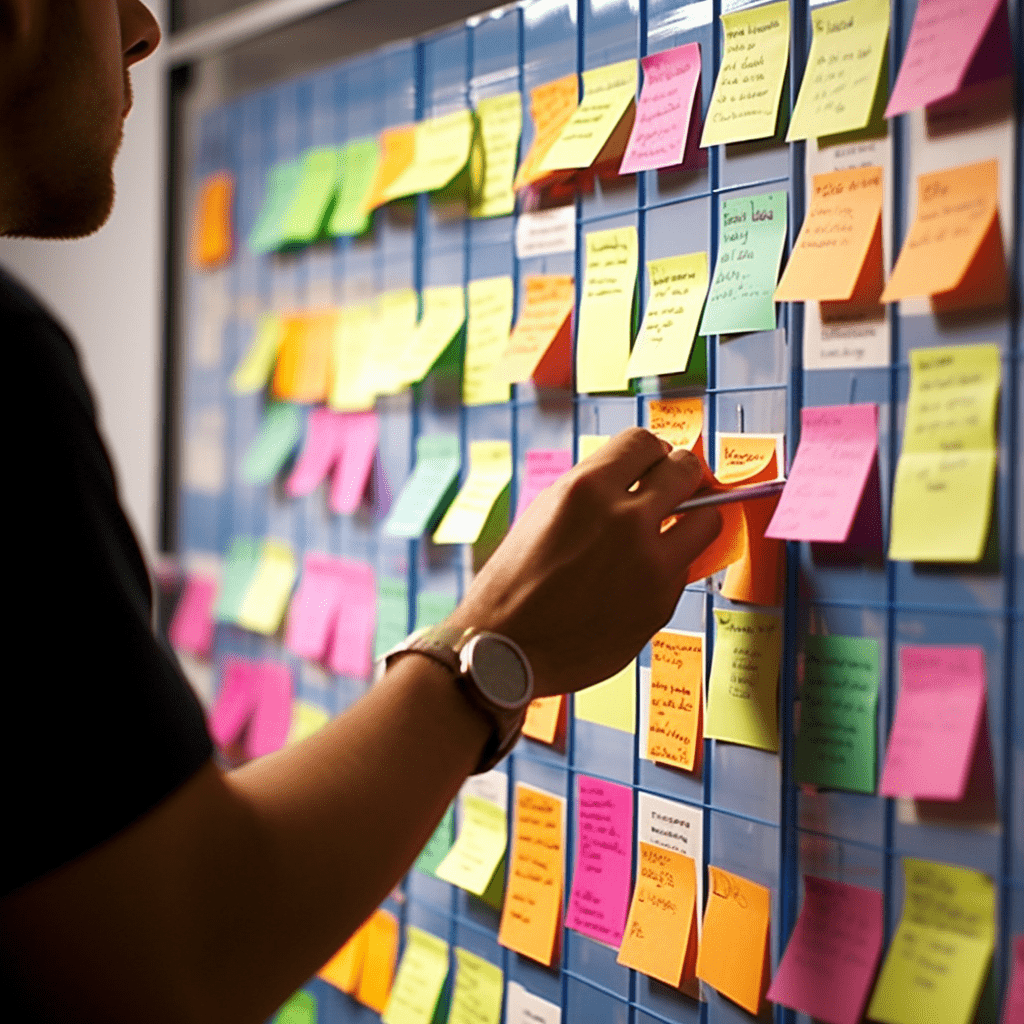Discover the Kanban Method Now: Explained in under 7 minutes
Definition: The Kanban Method is a lean and agile project management method that focuses on visualizing a workflow to enhance efficiency.
The fundamental concepts behind the Kanban Method are visualizing work, limiting work in progress, and optimizing flow. By representing tasks or work items as cards on a board, teams gain clarity, prioritize effectively, and achieve a steady workflow.
1. Origins and Background of Kanban Method
Kanban was developed by the Toyota’s engineer Taiichi Ohno in the 1940s, when it was introduced by him as part of the Toyota Production System (TPS). The japanese term “Kanban” meaning “signboard” or “visual card”. The system traces back to when Toyota used physical cards to signal the need for parts along their production line, ensuring a just-in-time supply chain and establishing a pull-based system that reduced inventory levels and improved workflow.
The TPS aimed to optimize manufacturing processes by minimizing waste and improving efficiency. Over time, the Kanban system evolved, transforming into a visual project management tool applicable to various domains.
2. What is the Kanban Method?
The Kanban method is a powerful framework that facilitates efficient task management, enabling teams to visualize their workflow, identify bottlenecks, and improve overall productivity.
Let’s take a look at the four core principles of the Kanban method to get a deeper understanding of its core values, followed by the six rules for implementing the Kanban method in an existing workflow, work projects, or everyday life tasks.
Example: Let’s say you’re a marketing manager responsible for social media campaigns. You can create a Kanban board with columns such as “Idea”, “Concept”, “Content Creation”, “Testing”, and “Published.” Each task card represents a specific campaign, and as you or the team progresses through each stage, they move the corresponding card across the columns. This visual representation enables everyone to track the status of campaigns, identify bottlenecks, and allocate resources effectively.
What are the 6 rules of Kanban Board Method?
The 6 Rules to Use a Kanban Board
- Visualize Workflow with a Kanban Board
- Limit the Work in Progress (WIP)
- Manage Your Flow
- Define Clear Policies
- Implement Feedback Loops
- Improve Collaboratively, Evolve Experimentally
1. Visualize Workflow with a Kanban Board:
A Kanban board is the heart of the system, consisting of columns representing the different stages of your workflow. Each task is represented by a card, that moves across the board as it progresses in the workflow. This visual representation allows team members to understand the status of each task at a glance.
2. Limit the Work in Progress (WIP):
Kanban emphasizes the importance of focusing on a limited number of tasks at a time. By setting a maximum WIP limit for each column, teams can prevent an overload and improve the flow of their work. Implementing this rule encourages completing tasks before starting new ones, avoiding multitasking and the associated inefficiencies.
3. Manage Your Flow:
The flow of work is critical in Kanban. By closely monitoring the movement of cards across the board, teams can identify bottlenecks, resolve hindrances, and optimize the overall flow. Regular meetings, such as daily stand-ups, provide opportunities for collaboration, status updates, and removing obstacles.
4. Define Clear Policies:
Explicitly defining the policies and rules governing each workflow stage helps maintain consistency and alignment within the team. Clear-defined rules eliminate ambiguity, provide guidelines for decision-making, and ensure everyone understands the expectations and criteria for moving tasks forward on the Kanban board.
5. Implement Feedback Loops:
Feedback loops are essential in Kanban to foster continuous improvement. Regularly reflecting on completed tasks, evaluating performance metrics, and collecting feedback from team members allows for improvement and opportunities for growth.
6. Improve Collaboratively, Evolve Experimentally:
Kanban encourages a culture of collaboration and experimentation. Embracing a growth mindset, teams should strive to improve their processes collaboratively and experiment with new approaches. By analyzing the impact of changes, teams can make informed adjustments and continuously evolve.
What are the 4 principles of the Kanban Board?
The 4 principles of the Kanban Method
- Start with what you know
- Regard change as an ongoing process
- Respect the current status
- Encourage leadership at all levels
The four principles of the Kanban method form the foundation for successfully implementing this project management system.
1. Start with what you know:
The first principle emphasizes the importance of acknowledging the current state of affairs and working with existing processes and practices. This allows for a smoother transition and minimizes resistance to change.
2. Regard change as an ongoing process:
The next principle emphasizes that change is an ongoing process. Rather than implementing sweeping, disruptive transformations and never looking at them again when implemented, Kanban encourages continuous improvement through small, incremental changes.
3. Respect the current status:
As well as starting with what is already there, a crucial principle when working with Kanban is to respect the already existent roles, responsibilities, and job titles. The importance of valuing and honoring the contributions of individuals within an organization. This principle promotes a culture of collaboration and cooperation while allowing for gradual adjustments over time.
4. Encourage leadership at all levels:
Finally, the last principle recognizes that leadership is not limited to a specific position or role. Kanban encourages everyone within the organization to take ownership and initiative, fostering a sense of empowerment and collective responsibility.
Key Points of the Kanban Method:
- The Kanban method is a visual project management system.
- In Kanban, you visualize your tasks by cards moving them from column to column as they progress.
- The method is agile but places more emphasis on a continuous flow than Scrum.
- Kanban focuses on flexibility but values what is already established
- It helps to identify bottlenecks in the process, point out pending tasks to team members, and continuous improvement.
- As an inventory control system, Kanban can be used for just-in-time (JIT) manufacturing and production and thus promotes waste reduction.
3. Kanban Board Method Examples in Everyday Life
These four principles collectively create an environment that nurtures continuous improvement, flexibility, and adaptability, enabling teams and organizations to thrive in a rapidly changing world.
Kanban’s versatility extends beyond professional environments and can also be implemented to facilitate various aspects of our daily lives. Here are two real-life examples to showcase how you can leverage Kanban techniques to enhance your own routines.
Example 1: Kanban Method for Cooking Preparations
For cooking preparation, a Kanban system would involve visualizing different cooking tasks on a Kanban board. Each task, such as chopping vegetables, marinating meat, or preheating the oven, would be represented as cards. As team members complete a task, they would move the corresponding card from the “To Do” column to the “Done” column. This allows for a continuous flow of cooking tasks, ensuring that all necessary preparations are completed.
Example 2: Kanban Method for Studying and Exams
Preparing for exams can often be overwhelming, with numerous subjects, chapters, and concepts to cover. Kanban can provide structure and clarity to your study routine. Create a Kanban board with columns representing different subjects or chapters. Each task card represents a specific topic or concept. Start by populating the “To Do” column with all the subjects or chapters you need to study. As you progress, move the cards from “To Do” to “In Progress” and finally to “Completed.” This visual system helps you track your progress, prioritize effectively, and ensure a balanced approach to your exam preparation.
Example 3: Kanban Method for a Cleaning Schedule
In a cleaning routine, a Kanban approach would involve visualizing different cleaning tasks on a Kanban board. Each task, such as vacuuming, dusting, or mopping, would be represented as cards. As roommates complete a task, they move the corresponding card from the “To Do” column to the “Done” column. This allows for a continuous flow of cleaning tasks, with a fair distribution of the tasks between the roommates.
Example 4: Kanban Method for a Home Renovation Project
When undertaking a home renovation project using Kanban, you can set up a Kanban board to visualize different project stages (e.g., planning, demolition, painting, electrical, etc.). Each specific task or subtask is represented as a card, and as you work on each task, you move the corresponding card across the stages. This allows you to have a clear overview of the project, manage work in progress, and track the progress of individual tasks.
4. Frequently Asked Questions about Kanban Method
1. What is the Kanban method?
The Kanban method is a visual project management system that focuses on visualizing work, limiting work in progress, and optimizing flow. It originated in the 1940s at Toyota and has since evolved to be applicable to various domains.
2. What are the six rules of Kanban?
The six rules of Kanban are:
- Visualize the workflow
- Limit your work in progress (WIP)
- Manage the flow
- State clear policies
- Implement feedback loops
- Improve, evolve, and experiment collaboratively
3. What are the four principles of Kanban?
The four principles of Kanban are:
- Start with the current process and what you already know
- Acknowledge change as an ongoing process
- Respect the current status with it’s roles, responsibilities, and job titles
- Encourage acts of leadership at all levels
4. Is Kanban agile or Scrum?
Kanban is considered an agile methodology, just like Scrum. However, Kanban places more emphasis on continuous flow and flexibility, while Scrum follows a time-boxed approach with iterations called sprints.
5. Does Kanban have Sprints?
Unlike Scrum, Kanban does not have sprints. Kanban focuses on continuous flow and allows for tasks to be worked on as capacity allows, rather than being confined to specific timeframes.
6. Is Kanban lean or agile?
Kanban can be considered both lean and agile. It embraces the lean philosophy of reducing waste, optimizing processes, and maximizing value. Additionally, Kanban aligns with the principles of agility by emphasizing adaptability, collaboration, and continuous improvement.
Conclusion
The Kanban Method is a versatile and powerful method that can revolutionize the way you work and manage tasks. By visualizing workflows, limiting work in progress, and optimizing flow. You can enhance productivity and achieve your goals more effectively.
Moreover, Kanban techniques are not limited to professional settings but can be applied to various aspects of your life. Embrace the principles of Kanban, experiment, collaborate, and unlock the potential of this exceptional methodology to unleash your productivity and streamline your daily routines!
Call to action: Remember, the power of Kanban lies in its simplicity and flexibility. Start small, visualize your tasks, and experience the transformative impact it can have on your life. So, grab your virtual or physical Kanban board, and try out the Kanban Method in one of your daily life challenges!
If you want to incorporate the Kanban method into your daily life, check out this article on Kanban board examples in everyday life.






